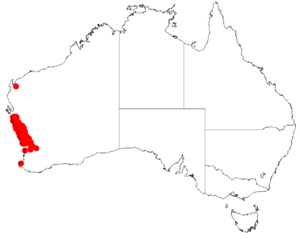Acacia blakelyi facts for kids
Quick facts for kids Acacia blakelyi |
|
|---|---|
| Scientific classification | |
| Genus: |
Acacia
|
| Species: |
blakelyi
|
 |
|
| Occurrence data from AVH | |
Acacia blakelyi is a type of plant that can grow as a shrub or a small tree. It belongs to the large group of plants called Acacia, which are often known as wattles in Australia. This plant was first described by a botanist named Joseph Maiden.
Contents
What Does Acacia blakelyi Look Like?
This plant usually grows to be about 1 to 3 meters (3 to 10 feet) tall. It has a dense, smooth appearance. Its small branches are a bit wavy.
Leaves and Flowers
Instead of typical leaves, Acacia blakelyi has what are called phyllodes. These are flattened leaf stems that act like leaves. They are green and shaped like long, narrow ovals. Each phyllode is about 7 to 15 centimeters (3 to 6 inches) long and 2 to 15 millimeters (0.08 to 0.6 inches) wide. They can also be quite sharp at the tip.
The plant blooms with bright yellow flowers from July to September. These flowers grow in small, round clusters. Each cluster is about 7 to 8 millimeters (0.3 inches) across and holds 20 to 30 golden flowers.
Seed Pods and Seeds
After the flowers bloom, the plant produces seed pods. These pods are mostly straight or slightly curved. They can grow up to about 16 centimeters (6 inches) long and 4 to 5 millimeters (0.16 to 0.2 inches) wide. Inside these pods are shiny black seeds. The seeds are shaped like small ovals and are about 5.5 to 7 millimeters (0.2 to 0.3 inches) long.
Where Does Acacia blakelyi Grow?
Acacia blakelyi is found naturally in the western part of Western Australia. It grows in areas known as the Wheatbelt and the Mid West regions.
Habitat
You can find this plant in sandy areas called sand plains, or on gentle hills. It prefers sandy soils that contain laterite, which is a type of reddish soil rich in iron.
It often grows as part of the lower layer of plants in woodlands or tall shrublands. This means it grows beneath taller trees or shrubs, forming an important part of the plant community in these areas.

